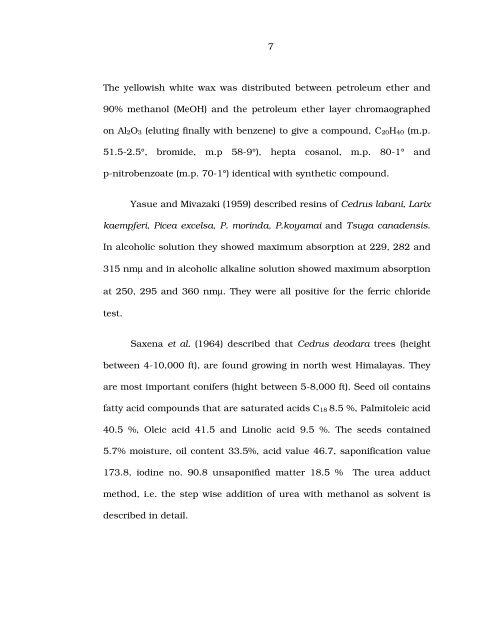REVIEW OF LITERATURE
REVIEW OF LITERATURE
REVIEW OF LITERATURE
Create successful ePaper yourself
Turn your PDF publications into a flip-book with our unique Google optimized e-Paper software.
7<br />
The yellowish white wax was distributed between petroleum ether and<br />
90% methanol (MeOH) and the petroleum ether layer chromaographed<br />
on Al2O3 (eluting finally with benzene) to give a compound, C20H40 (m.p.<br />
51.5-2.5°, bromide, m.p 58-9°), hepta cosanol, m.p. 80-1° and<br />
p-nitrobenzoate (m.p. 70-1°) identical with synthetic compound.<br />
Yasue and Mivazaki (1959) described resins of Cedrus labani, Larix<br />
kaempferi, Picea excelsa, P. morinda, P.koyamai and Tsuga canadensis.<br />
In alcoholic solution they showed maximum absorption at 229, 282 and<br />
315 nmμ and in alcoholic alkaline solution showed maximum absorption<br />
at 250, 295 and 360 nmμ. They were all positive for the ferric chloride<br />
test.<br />
Saxena et al. (1964) described that Cedrus deodara trees (height<br />
between 4-10,000 ft), are found growing in north west Himalayas. They<br />
are most important conifers (hight between 5-8,000 ft). Seed oil contains<br />
fatty acid compounds that are saturated acids C18 8.5 %, Palmitoleic acid<br />
40.5 %, Oleic acid 41.5 and Linolic acid 9.5 %. The seeds contained<br />
5.7% moisture, oil content 33.5%, acid value 46.7, saponification value<br />
173.8, iodine no. 90.8 unsaponified matter 18.5 % The urea adduct<br />
method, i.e. the step wise addition of urea with methanol as solvent is<br />
described in detail.

















